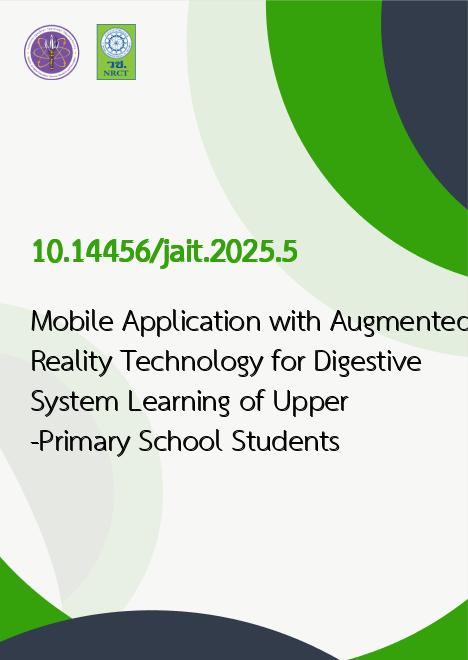
|
Mobile Application with Augmented Reality Technology for Digestive System Learning of Upper-Primary School Students |
|---|---|
| รหัสดีโอไอ | |
| Creator | Nipaporn Chanamarn |
| Title | Mobile Application with Augmented Reality Technology for Digestive System Learning of Upper-Primary School Students |
| Contributor | Surasit Uypatchawong, Komcharn Suwannapan |
| Publisher | Faculty of Informatics, Mahasarakham University |
| Publication Year | 2568 |
| Journal Title | Journal of Applied Informatics and Technology |
| Journal Vol. | 7 |
| Journal No. | 1 |
| Page no. | 57-72 |
| Keyword | Mobile Application, Augmented Reality Technology, Android, Digestive System |
| URL Website | https://ph01.tci-thaijo.org/index.php/jait |
| Website title | Journal of Applied Informatics and Technology |
| ISSN | 3088-1803 |
| Abstract | The objectives of this research were four fold: 1) to develop a mobile application using augmented reality technology for teaching the digestive system to upper-primary school students, 2) to assess the effectiveness of the mobile application in facilitating digestive system learning, 3) to evaluate performance using the E1/E2 formula during the use of the mobile application, and 4) to assess satisfaction with the mobile application for digestive system learning. The development process followed the Software Development Life Cycle (SDLC), utilizing the C# language in the Visual Studio Code Program and creating models with the Unity and Blender Programs. The research employed various assessment tools, including performance evaluations by five experts, pre-test and post-test assessments from 18 students, and satisfaction assessments from a sample of 58 individuals using cluster sam-pling selection methods. Statistical measures used included mean, standard deviation, and the efficiency criteria of 80/80 using the E1/E2formula. The findings revealed that the mobile application for digestive system learning for upper-primary school students, incorporating augmented reality technology, featured a total of eight models. The application operated in two ways: 1) users could learn by scanning through Marker sheets, and 2) learning by selecting content from the menu could serve as a learning medium for students, enabling individuals interested in the topic to learn at any time. Considering the results of the evaluation, the overall efficiency was at the highest level (x_bar=4.90, S.D.=0.17), with E1/E2efficiency at 80.56/83.89, surpassing the required performance. Academic achievement demonstrated a statistically significant increase in post-test scores compared to pre-test scores at a p-value of .05. User satisfaction among the sample was reported at the highest level (x_bar=4.75, S.D.=0.45). In conclusion, this application is a practical and suitable study material for students and individuals interested in the topic, allowing flexible learning opportunities at any time. It can be used as teaching material in science learning groups and proves useful for schools, helping to reduce the cost of purchasing study materials for students. |